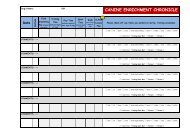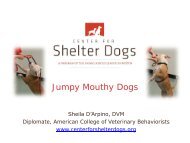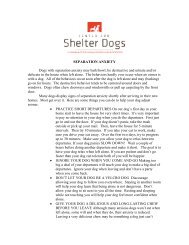BEHAVIOR MODIFICATION PLAN - Center for Shelter Dogs
BEHAVIOR MODIFICATION PLAN - Center for Shelter Dogs
BEHAVIOR MODIFICATION PLAN - Center for Shelter Dogs
You also want an ePaper? Increase the reach of your titles
YUMPU automatically turns print PDFs into web optimized ePapers that Google loves.
IN ADDITION, THE <strong>PLAN</strong> SHOULD INCLUDE:<br />
1. Training sessions during time outdoors:<br />
• Praise/treat or click/treat in order to reward friendly or neutral behavior (not<br />
fearful, not aggressive, but not friendly). Be cautious: some fearful dogs are<br />
afraid of the noise of the clicker. These dogs will need to be desensitized and<br />
counter-conditioned to the clicker be<strong>for</strong>e using it, or you may wish to use praise/<br />
treat instead of click/treat with noise sensitive dogs.<br />
• On walks, when the dog looks at strangers (without aggression) praise/treat or<br />
click treat.<br />
• Stand in low traffic areas outdoors with the dog next to you.<br />
If a stranger passes and the dog looks at them (without aggression), praise/treat<br />
or click/treat. If the dog attempts to move away, allow the dog to move away.<br />
During training, avoid high (people) traffic areas.<br />
• Do NOT allow strangers to approach/pet the dog.<br />
2. Office foster (5 days/week): Reference the Office Foster <strong>for</strong> Shy <strong>Dogs</strong> doc.<br />
ADDITIONAL OPTIONAL EXERCISES:<br />
If your shelter has enough resources, you might consider additional training<br />
exercises to reduce the dog’s fear of people.<br />
1. Target training: Initially train the dog to touch a target, and then train the dog to<br />
touch (target) hands/feet, initially of people the dog knows and then of people to<br />
whom you wish to introduce the dog.<br />
2. Tossing treats (desensitization and counter conditioning): Plan sessions with<br />
volunteers or staff that the dog does NOT know. Ask the helper to gently (no sudden<br />
movements) toss treats toward the dog.<br />
As this treatment plan progresses, the helper should toss treats closer and closer<br />
to their location. The trainer and helper must carefully observe the dog’s body<br />
language <strong>for</strong> signs of stress, fear, or aggression, which would indicate that you are<br />
not appropriately desensitizing the dog. Over time and multiple sessions, if the dog<br />
is demonstrating friendly behavior and voluntarily approaching helpers, helpers can<br />
begin to offer treats from their hand, and eventually begin touching the dog on the<br />
chest or withers.










